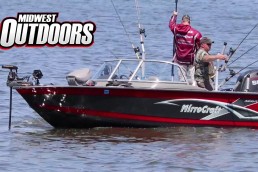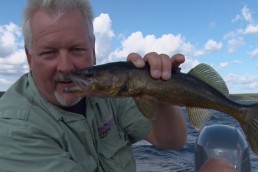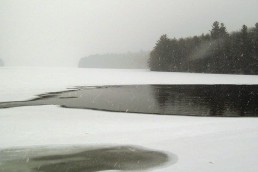Winter Walleye Ice-Fishing: A Contact Sport
SHARE THIS POST
When walleye ice-fishing, check the choke points
Consistent walleye ice-fishing often means finding the edge or structural element that funnels fish movement. When fish move through a particular location, they pass through that spot. Amazingly, these fish movements are often so precise that most of the fish come through a location passing along the same route, often from the same direction.
The beauty of walleye ice-fishing is that walleyes love structure. With structure, fish movements and locations are seldom random. With the accuracy of map chips and lake contours, finding and understanding structure is no longer a guessing game and our ice-fishing can be amazingly accurate. On many lakes, walleyes roam during low-light periods or after dark. On some locations, fish loaf and lay off the structure over the deep transition or bottom of the break and then slide up onto the structure when they get active. This shift is an opportunity. Identify this contact point where these fish travel, and you are on the fast track to catching more walleyes this winter.
Know your target
To visualize these locations for walleye ice-fishing, picture a deer stand for bowhunting. You know where the deer bed and you know the cut alfalfa field that the deer will walk out into after dark. Now, picture the travel routes and pinch points that deer use to get from point A to point B. Walleyes operate much the same way. Both critters are edge oriented.
On many lakes and reservoirs, this prime time movement occurs around sunrise and sunset. Some bites happen well after dark. That said, if the fish are moving, you can set up over a good spot and contact them. When the fish are not moving, the only way you can catch fish is to keep moving.
Add even more thrill to your walleye catch. Fish at night!
Are you enjoying this post?
You can be among the first to get the latest info on where to go, what to use and how to use it!
Keep still, keep quiet
So far this winter, we haven’t had a lot of ice. As I write this, we are still hanging on six inches of ice on many locations across Devils Lake. The fish have been much spookier than normal, too. Much banging or even just walking around, right now, makes the fish shut down. The best program I have found for catching nice walleyes ice-fishing, so far this winter, has been to get to a spot, pick the “x” and set up over that one hole. Wait out fish movements without doing anything to disturb the spot. Don’t walk much, don’t drive and don’t drill.
At times, fish seem oblivious to what is going on above them. Other times, activity gets them swimming around and makes them catchable. With the fish on Devils Lakes spooky this winter, we drill and fish a few holes on a prime spot and wait out the fish. The activity comes in pulses as schools of fish cruise through. When angler activity shuts down walleyes, sitting on the sweet spot becomes crucial. However, the spook factor can vary from water to water. We have seen situations on the Fox River Chain in northern Illinois where anglers used tip ups in 4 or 5 feet of water over large sand flats. They had to wait on shore for flags. Walking on the ice shut the fish down.
We have seen situations with panfish where the fish wouldn’t swim under an ice shelter. On other water, anglers routinely use deadsticks deployed with Arctic Fisherman or tip-ups just to spread lines and fish water remotely. Every body of water has its own nuances and less ice seems to heighten some of these nuances. Thinner ice means less buffers to human activity above and also allows much more light penetration.
Study up before you set out
Regardless of ice conditions, however, there is a lesson to be learned. Spend some time to really study contour maps and learn how walleyes use that particular piece of structure. The only sure way to really understand a location is to put in some time on the spot. The key is to identify where the fish lay when they are inactive and where they roam when they become active. Find the edges and contours that walleye follow and ambush them this winter.
Jason Mitchell is a top walleye guide on Devils Lake, N.D. and hosts the program “Jason Mitchell Outdoors.” Visit jasonmitchelloutdoors.com.
MWO
SHARE THIS POST
Did you enjoy this post?
You can be among the first to get the latest info on where to go, what to use and how to use it!
Jason Mitchell
Jason Mitchell was a top walleye guide on Devils Lake, N.D. for nearly 20 years. Today, Mitchell produces the Jason Mitchell Outdoors TV program. Visit jasonmitchelloutdoors.com for more.



